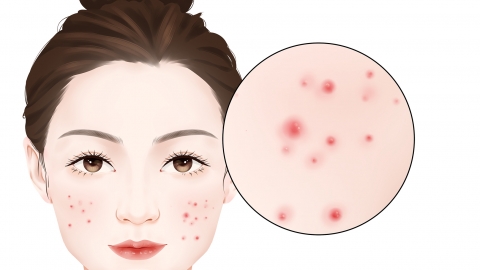What causes pimples and acne on the face?
Generally speaking, pimples refer to acne. Facial acne and pimples may be caused by factors such as dietary habits, improper cleansing, seborrheic dermatitis, polycystic ovary syndrome (PCOS), and Cushing's syndrome. If discomfort occurs, timely medical consultation is recommended. Detailed explanations are as follows:

1. Improper Diet
Long-term consumption of high-sugar, high-fat, and spicy or irritating foods may rapidly elevate blood glucose levels, stimulate insulin secretion, and subsequently affect hormone levels in the body. This can increase sebaceous gland secretion, disrupt skin metabolism, and lead to or worsen acne and pimples. It is advisable to adjust dietary habits by consuming more vegetables and fruits rich in dietary fiber, while reducing intake of high-sugar, high-fat, and spicy foods.
2. Improper Cleansing
If facial cleansing is inadequate, dust, dirt, oil, and dead skin cells may accumulate at the follicular openings, blocking pores and preventing normal sebum drainage, which can lead to acne and pimples. It is important to choose a facial cleanser suitable for one's skin type and wash the face twice daily, morning and night, using gentle techniques to avoid over-cleansing and damaging the skin barrier.
3. Seborrheic Dermatitis
Seborrheic dermatitis may be related to Malassezia infection, excessive sebaceous gland secretion, and impaired skin barrier function. Inflammatory stimulation may lead to symptoms such as redness, oily scales, acne, and pimples, often accompanied by hair loss and itching. Patients may follow medical advice to use medications such as ketoconazole shampoo, roxithromycin granules, and selenium sulfide shampoo for treatment.
4. Polycystic Ovary Syndrome (PCOS)
Polycystic ovary syndrome is mainly associated with genetic and environmental factors. Patients often have elevated androgen levels and imbalanced gonadotropin ratios, leading to endocrine disorders. Increased androgen levels stimulate excessive sebum production by sebaceous glands, which blocks hair follicles and causes acne and pimples. Symptoms such as menstrual irregularities and obesity may also occur. Patients may follow medical instructions to use medications such as levonorgestrel tablets, combined norethindrone tablets, and dexamethasone tablets to alleviate symptoms.
5. Cushing's Syndrome
Cushing's syndrome is often caused by excessive pituitary secretion of adrenocorticotropic hormone (ACTH), adrenal cortical tumors, or long-term use of corticosteroid medications. Elevated cortisol levels in the body can affect the metabolism of carbohydrates, fats, and proteins, leading to endocrine disorders. High cortisol levels stimulate increased sebum production, resulting in oily skin and the development of acne and pimples. Symptoms such as central obesity and purple skin striae may also appear. Patients can follow a doctor's recommendations to use medications such as aminoglutethimide tablets, mifepristone tablets, and etomidate injection for treatment.
In daily life, avoid frequently touching the face to prevent bacterial infections; avoid prolonged sun exposure and take proper sun protection measures; reduce all-nighters and maintain a regular lifestyle.




